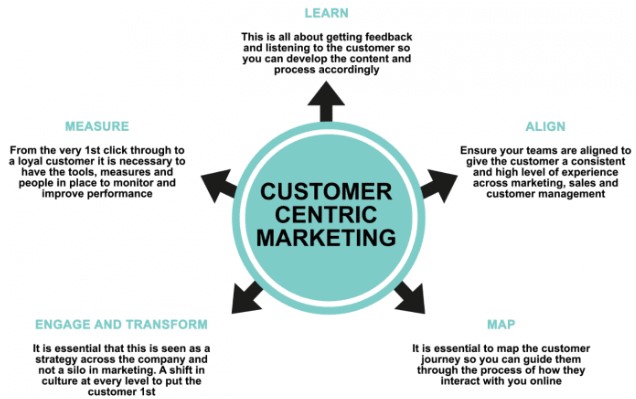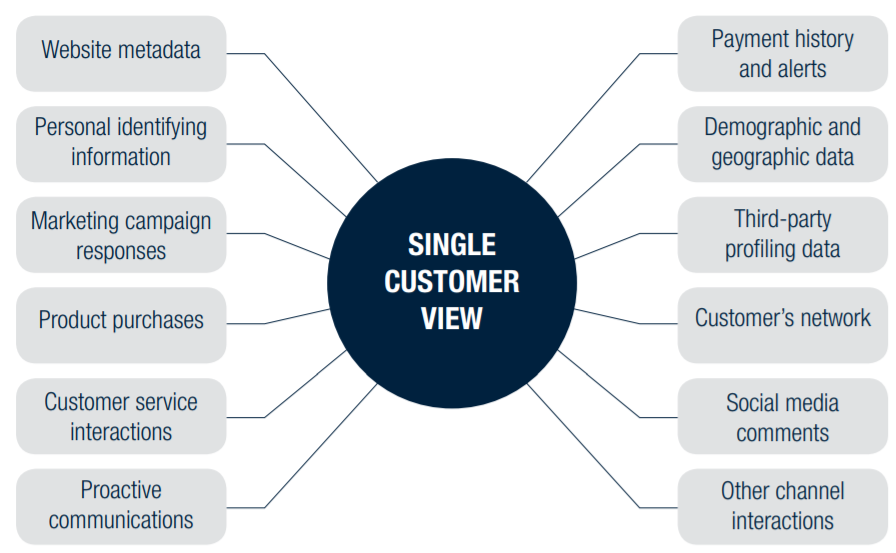Customer experience is an essential component of success for B2B companies. Building brand loyalty and encouraging long lasting customer relationships can help boost your company’s overall return on investment (ROI).
While having a good product still matters, customer experience has added an additional layer of competition between B2B businesses. A customer centric business model will require transparency across departments and a deep understanding of client behavior.
Through a single customer view, your entire company should be able to access relevant data on clients, regardless of the department. By integrating this into your business strategy, your company can stay on top of the journey and experience your clients receive.
Keep reading to learn about a single customer view, or use the following links to jump ahead:
- What is a Single Customer View?
- The Benefits of a Single Customer View
- What is Customer Intelligence?
- Single Customer View Vs.Traditional Marketing Tactics
- Implementing Single Customer View Into Your Company
- Key Takeaways
What is a Single Customer View?
Simply put, a single customer view is a consistent collection of data that can be accessed by all departments for an accurate summary of clients. Going a little deeper into this strategy, a single customer view is implemented through the daily systems your team uses.
By investing in software that provides the ability to collect this data across departments, your business is able to begin benefiting from this information. This should help your departments seamlessly transition customers between each stage of the buyer’s journey, which will improve the overall customer experience.
A single customer view helps avoid any issues in the buyer’s journey. By aligning data and company goals into one platform, the amount of miscommunication between departments is minimized. This also allows your company to track key performance indicators (KPIs) across all teams, which can help pinpoint problem areas and provide insight into which areas need improvement.
Most importantly, this strategy will help your team make sure the customer is central to all business decisions. According to a Gartner Trend Insight Report, 80% of organizations within the B2B industry are competing with each other on customer experience rather than solely on the product.
By having a data-driven customer strategy, your company will remain competitive within the industry. Gartner also found that 50% of companies have found a way to track the financial gain of customer experience initiatives. Not only will a single customer view help improve the overall journey, it can also provide valuable financial insights for your company.
The Benefits of a Single Customer View

A successful customer experience doesn’t happen overnight. While your product might help meet a client’s needs, the buyer journey is just as important as the end result. A great starting point for improving the sales cycle is taking a customer centric approach.
This means relying on accurate data to evaluate the journey as well as identify areas of improvement.
With social media marketing and online buying continuing to rise in popularity, the customer journey begins before the prospect is introduced to an actual salesperson. In some instances, they may not even speak with a salesperson until they are ready to make a purchase.
Because of this, utilizing a single customer view can help all your departments improve their interactions with new site visitors and existing clients.
One of the biggest benefits of a single customer view is cleaner data. Information from your target audience and current customers is valuable for informing future product decisions. Traditional marketing and sales practices don’t constantly communicate across departments, which can lead to information being siloed.
By having up-to-date contact information, customer history, and data based on marketing engagements, all departments will be able to see the buyer’s journey in real-time. This helps encourage communication between teams when there is an issue that needs to be addressed or when tactics are yielding positive results.
This also helps cut down duplicate information. Rather than multiple departments logging similar data, a single view allows your team to see what has already been recorded. This keeps your data clean and coherent.
A single customer view allows your team to have access to better insights. An accurate portrayal of the buyer’s experience can help employees measure the success of campaigns and sales tactics. This provides value to your marketing department as they can plan for future outreach to find the right audience.
Alongside having a clearer idea of what the customer experiences, this tactic helps your team measure KPIs accurately. Assigning data driven metrics is a great way to encourage your teams to meet their goals. By using this data, your company is able to create realistic KPIs and re-evaluate when teams are not hitting the mark.
Understanding customer behavior helps your marketing department track which channels are best for campaigns. A single customer view tracks customer engagement across platforms to determine what’s most likely to gain interaction from your target audience. This insight can help your company allot the proper resources for the most successful channels.
A single customer view helps optimize your company’s workflow to produce the best results. From the beginning of the sales process, leads are identified and qualified in the same platform. This helps marketing and sales departments accurately segment audiences to ensure each qualified lead is being nurtured by the right team.
Leadboxer, with its unique offering of the platform’s native integrations combined with the integration of the best email marketing applications, allows your team to integrate with your current techstack. This cuts down on unnecessary duplication between programs, and allows your employees to work with familiar software.
Techstack integration is a major benefit of the single customer view. It helps your marketing department track engagement across multiple channels including email, social media and website engagement. When implemented on a lead data platform, data is collected and accessible for all teams.
What is Customer Intelligence?
It is not a secret that customers are getting quicker and more efficient during the sales process. With the rise of online sales, prospects are able to conduct their own research and engage with a free trial before speaking to a salesperson.
However, customer intelligence does not refer to an increase in self-sufficient prospects. Rather, it defines the process of collecting data to understand insights about consumer behavior. This helps companies create a successful customer journey that provides an excellent experience.
Customer intelligence is more than using data to achieve client satisfaction. It is a practice that helps companies fine tune their internal processes, tighten up marketing campaigns and boost customer retention.
Understanding the target audience, or the ideal client profile, for your product is a crucial first step to B2B success. Customer intelligence takes this one step further by helping provide insights into the behavior of real leads and customers.
Expanding upon the client profile, data from current customers and potential leads can inform the decisions your company makes for marketing and sales campaigns.
Customer intelligence comes from multiple sources and tracks a variety of consumer data. On the internal side, this information can come from outbound calls, sales pitch meetings and interactions with your customer success team.
Internal customer intelligence is generated any time a member of your company interacts with a client. Between marketing, sales and customer success, the number of interactions can start to add up quickly. To avoid missing important feedback or duplicating efforts, storing this data in a platform with a single customer view can be a huge help.
As your teams gather internal information, the client profile can be updated in real time to reflect the customer’s current position in the sales funnel. This data benefits every department.
Your marketing team will be able to segment customers to ensure they are receiving relevant campaigns. Salespeople will be able to create a timeline for communications and set follow-up reminders. Customer success can make sure onboarding materials are prepped.
External data comes from a variety of sources including personal demographics, geographic location and marketing campaign engagement. Using website metrics as external data helps your team identify and qualify potential leads as they interact with your pages.
Successful customer intelligence relies on both external and internal data to provide informed patterns of client behavior. Just like internal information, external data should be stored in your single customer view platform. This information helps give a complete client profile alongside the interactions with your company.
Overall, customer intelligence will help boost your ROI and increase customer retention. Prioritizing the customer experience and tailoring methods through data-driven decisions helps create lasting business relationships.
Having a customer centric approach means your target audience is at the forefront of all business operations. By storing your customer intelligence on a single view platform, the ‘customer first’ approach can be implemented easily across all departments.
Single Customer View Vs. Traditional Marketing Tactics

Although proper software is an important component, the single customer view is more than just utilizing a platform. It is a process for storing data that helps your company provide the best customer experience. To be successful in this strategy, using an integrated platform like Leadboxer is a good place to start.
Traditionally, marketing and sales teams work side-by-side, but not always together. The sales department may put more focus on warm leads, while the marketing team spends their time identifying prospects.
When these employees are working with different types of clients, it is easy for miscommunication to occur. Salespeople may be having active conversations with a customer while the marketing department is adding them to a segmented list of prospects that haven’t been contacted. While this may not seem like a huge slip up, it is a waste of time, and it may confuse potential clients.
The single customer view helps eliminate these mistakes by allowing both teams to work simultaneously with the same data. Using Leadboxer puts important information into one easy-to-access platform. This software allows your marketing department to track email campaigns and website engagement, while your salespeople are sharing where prospects are at in the sales cycle.
Leadboxer provides more than just the ability for teams to see the same data. It encourages collaboration between departments, so customers get the right amount of attention and client relationships are continuously nurtured.
Knowing where someone is in the buyer’s journey helps both teams develop a strategy to close the deal. Sales and marketing employees can work together to determine the best segmentation of audiences and which campaigns each lead type should receive.
Eliminating the silos of information within departments will help your company embrace a customer centric approach. There is more to a successful client experience than getting a sale across the finish line. Proper communication and clean data will make a huge difference in providing a positive experience for those in the sales journey.
The single customer view also promotes brand loyalty. It is cheaper to continue servicing an existing client than it is to onboard a new one. That does not mean prospects are not important, but it does mean cultivating strong customer relationships can lead to a higher ROI.
Implementing Single Customer View Into Your Company
Once you have a grasp on the concept, it’s time to start implementing a single customer view into your business. While your company should already have a customer centric approach, developing a process for a single customer view can further improve the client experience.
It may seem like a big undertaking, but the following steps can get you on the right track:
Collect Your Current Data
This sounds simple enough, but if you haven’t been storing your data in one platform, it may take awhile to complete this step. First, determine who is in charge of storing information in each department.
Collaborate with these employees to understand what type of data they have been collecting and why it is relevant to your customer experience. From there, begin compiling the information and cleaning up any duplicates.
This data may include contact information, personal demographics, previous customer interactions, marketing engagement and purchase history. Talk with your employees to figure out how this data is being used within each department. This will help determine the best ways to store and collect data once you have implemented your single customer view.
Decide Which Platform Best Fits Your Needs
It is important to find software that will help your team align its goals and share data across departments. Leadboxer takes a cutting edge approach to data analysis while integrating with your current techstack for easy implementation.
It is important for your team to be able to do it all in one location. From identifying leads, qualifying and scoring, Leadboxer is there to help from the very beginning of the customer journey. This platform does more than just filter through website traffic to identify prospects. It provides a series of integrations to help analyze important customer data.
Leadboxer can integrate with CRMs to help optimize workflow and make sure your sales team is spending time on the leads with the most potential. Marketing departments will benefit from its ability to track engagement and store valuable information. The rest of your company will have access to this data, which helps inform future campaigns, customer success outreach and financial decisions.
Determine KPIs Across Departments
The best way to measure the success of your customer centric approach is to set goals across departments. Using KPIs can help your teams stay on track and refine the customer experience.
While everyone will be working off of a single customer view, their tasks will be different. Therefore, it is important to provide clear objectives.
If teams are succeeding in meeting or exceeding their KPIs, your company will be able to see the positive effects within their customer relations. If teams are coming up short, it may be a sign to redirect efforts and come up with a new strategy.
The important thing to remember when implementing a single customer view is to allow room for growth. The first approach may not be the best one. Your measuring KPIs will help your managers guide teams through this process.
KPIs can also help provide insight into areas of improvement within the customer journey. If you notice negative customer feedback regarding specific parts of the sales cycle, your team will be able to adjust and improve their actions.
Utilize Data Managers
This step may be better suited for bigger companies, but if you can, dedicate a role to data management. This will help ensure that your platform contains the most up-to-date information without having duplicate or old data.
This role can also help analyze data to inform teams about how customers are feeling. With one person focusing solely on organizing and cleaning information, departments can feel confident in the data they are using.
Data managers may provide valuable insight for process improvement as well. Once you’ve taken on a platform for your single customer view, processes should be developed and implemented across departments. With constant audit by a data manager, workflow optimization can be handled easily.
Develop and Implement Company-Wide Processes
While the specific actions vary across teams, taking the time to determine best practices makes sure your company benefits from a single customer view. Managers should meet to discuss the way each department uses data currently, and processes can be built out based on these conversations.
When developing these workflows, efficiency should be a top priority. Since all of the data will be stored in a single platform, it’s important to cut down on any actions that may duplicate efforts. For example, if sales and marketing departments were both previously qualifying prospects, decide which team should take that on in the new process.
Take the time to introduce and properly train employees on these processes. Employees should feel comfortable accessing and inputting data into the new platform. Make sure they understand how their current techstack integrates and works with the single customer view.
It’s important to make sure this transition causes minimal interruption to current client relationships. Ensure your departments feel confident in the new processes before letting them loose with the new system.
When deciding what processes should be implemented, make sure customer experience is at the forefront of these decisions. Any changes made should benefit your company’s overall ability to provide top tier services.
Key Takeaways
For B2B companies that want to remain competitive in the industry, successfully taking a customer centric approach is crucial. Pairing customer intelligence with a single customer view can help put your company ahead of others while promoting brand loyalty among your clients.
Investing in LeadBoxer, a fully integrated lead generation platform, can ensure that implementation of this strategy benefits all departments. Make sure your teams are onboard with these changes by providing ongoing support so they can utilize the platform to its fullest potential.
With a constant focus on improvement, your customers will feel valued. It’s important to evaluate the current buyer experience. Using the data collected and analyzed by Leadboxer, your teams will be able to gain valuable insight into customer behaviors.
Allow data to drive your decisions. A single customer view can help take the guesswork out of marketing and sales tactics. Use previous customer interactions and tracked website engagement to plan future campaigns.
Encourage your departments to collaborate based on the gathered information. By having a sales and marketing team that works together, customers can experience a seamless hand off between stages in the buying journey. Customer success teams will be able to track and preemptively do outreach to ensure the best possible post-purchase relationship.
Using a single customer view helps create a robust strategy for managing client relationships. Prioritizing the buyer experience through segmented outreach, personalized sales calls and efficient customer support will increase client retention.
Above all, make sure your company is encouraging employees to value customers. Lasting relationships lead to repeat purchases, referrals and higher sales conversions.
Get started with your single customer view, and try Leadboxer for FREE today!
